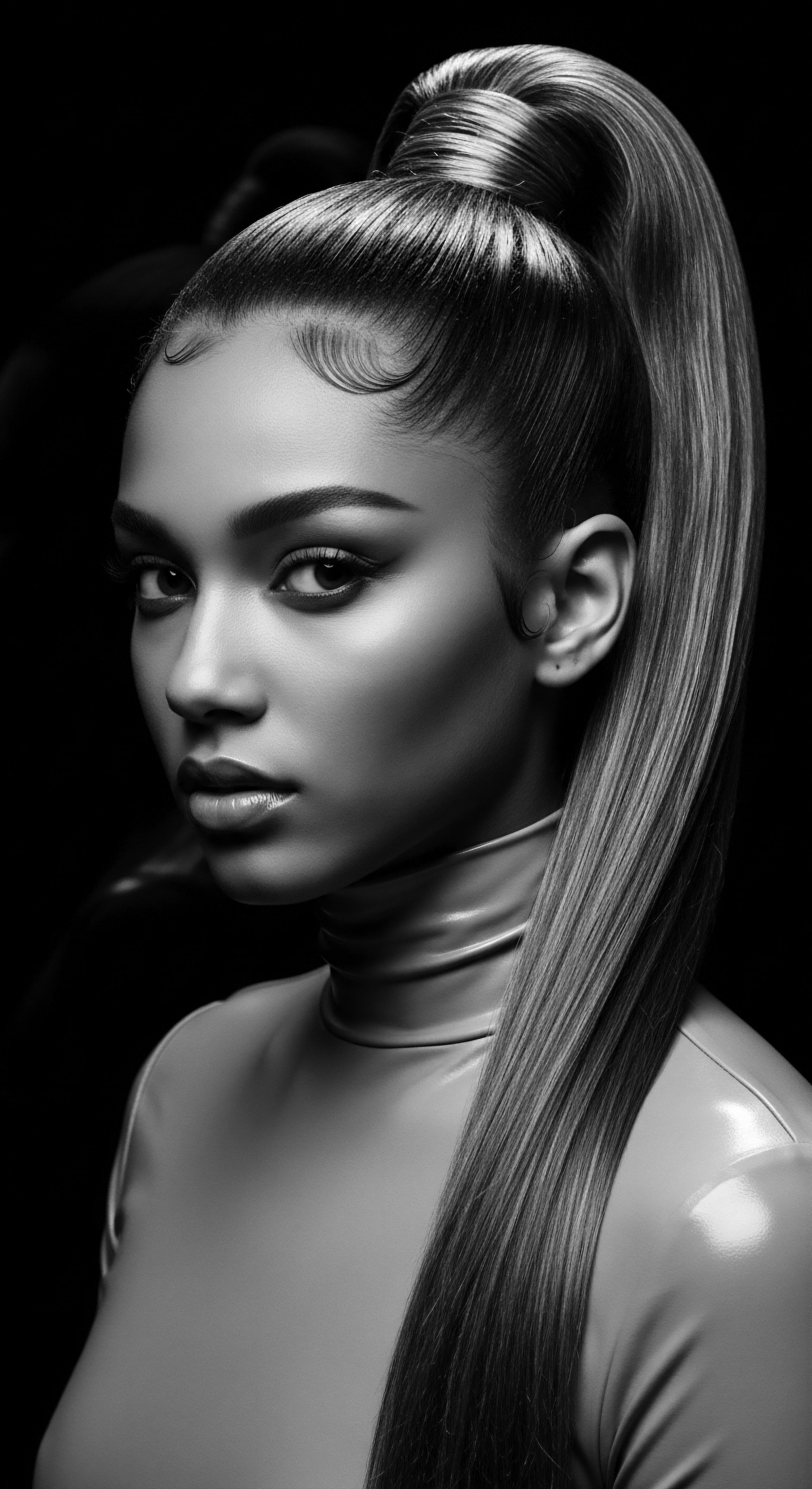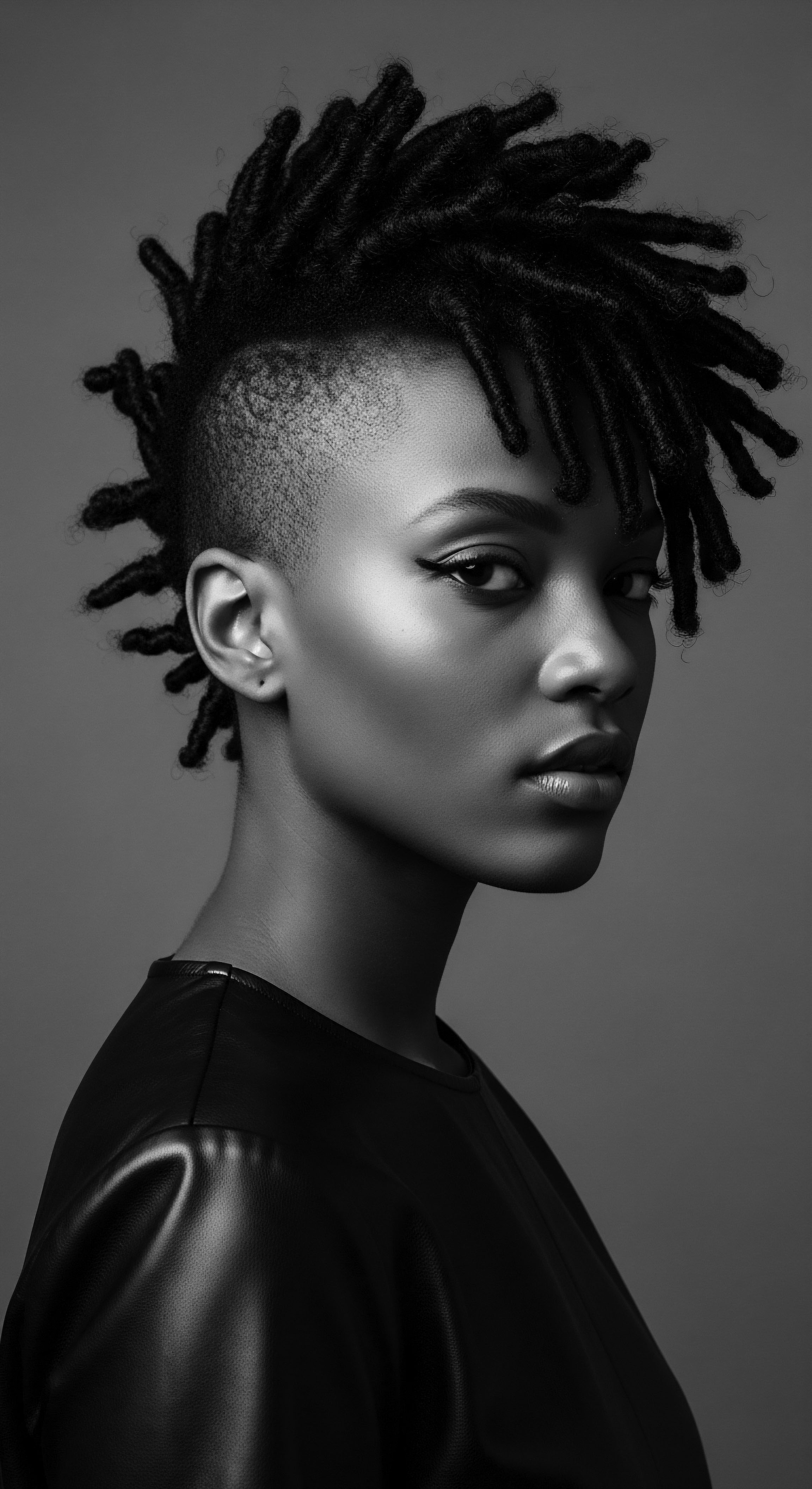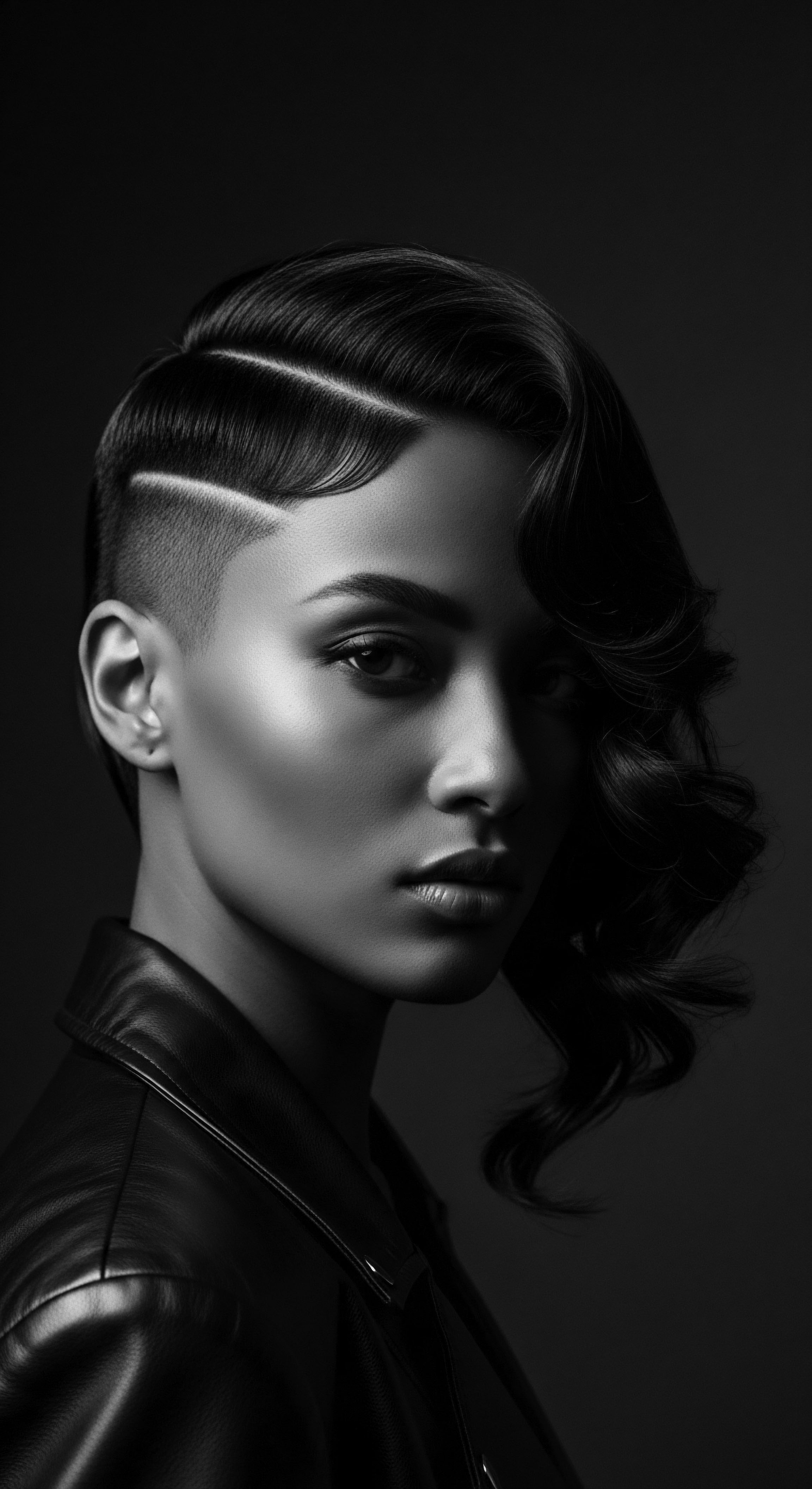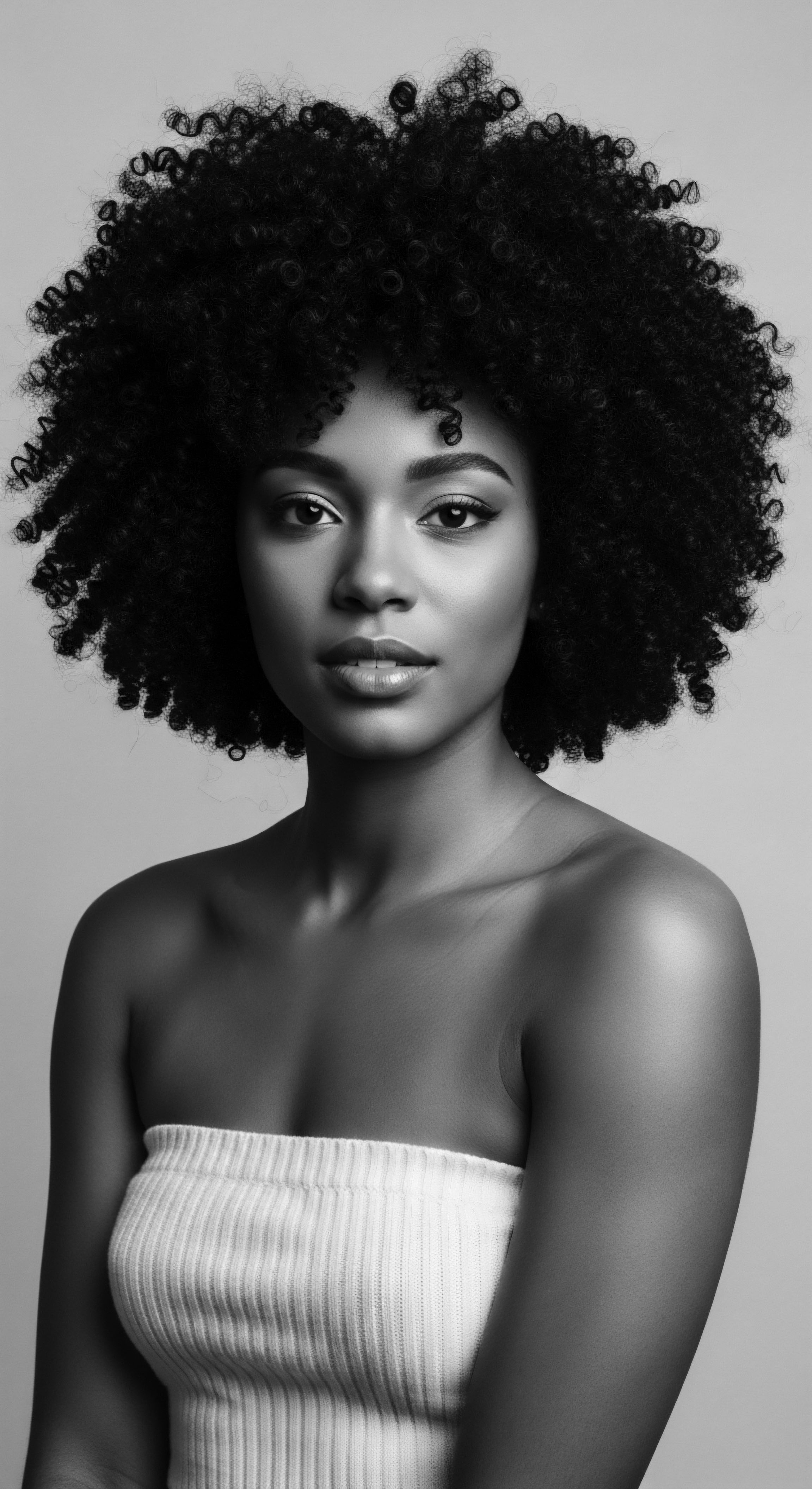
Roots
Consider for a moment the gentle whisper of generations past, carried on the very coils and kinks that crown your head. Each strand, in its glorious architecture, holds not simply genetic code, but echoes of communal life, of hands joined in care, of traditions upheld long before colonial currents reshaped global understanding. To truly grasp what communal aspects defined pre-colonial hair care rituals, one must feel the soil from which these practices sprouted, recognizing that hair, especially textured hair, was never an isolated adornment; it was a living archive, a communal canvas, and a vibrant declaration of identity.
The foundational understanding of textured hair, from an ancestral and scientific heritage perspective, begins not in laboratories, but in the shared spaces where communal care unfolded. Our ancestors possessed an intimate knowledge of hair’s inherent nature, a wisdom gleaned through observation, inherited practices, and an unbroken connection to the earth’s bounty. This ancestral insight, deeply intertwined with elemental biology, recognized the unique cuticle patterns and curl formations that distinguish textured hair, allowing for bespoke care rituals long before modern scientific classification systems emerged. The very act of care was often a collective endeavor, reinforcing bonds.
The physical characteristics of hair—its varying porosity, elasticity, and density—were intuitively understood within these pre-colonial contexts. Communities recognized, for instance, how different hair types responded to moisture, how certain oils sealed the strands, or how specific herbs cleansed the scalp. This was not abstract science; this was lived experience, passed down through the gentle braiding sessions and the shared application of plant-based remedies.
The understanding of hair anatomy was observational, yes, but profoundly effective, aligning perfectly with the hair’s inherent need for hydration and protection. The wisdom was practical, born of necessity and tradition.

How Did Pre-Colonial Communities Classify Textured Hair?
While formal, rigid classification systems like those seen in contemporary hair care were absent, pre-colonial communities developed their own nuanced ways to categorize and speak about hair. These distinctions often centered on visual characteristics, tactile qualities, and, most powerfully, on hair’s social and spiritual significance. The language used was rich with descriptors that reflected regional variations, tribal affiliations, and familial lines.
Hair types might be spoken of in terms of their resemblance to natural phenomena—the tight spirals of certain plants, the ripple of water, or the texture of specific barks. The very lexicon was imbued with connection to the natural world.
Consider the rich vocabulary of West African communities, where terms for hair styles and textures were inextricably linked to social status, age, marital state, and ceremonial roles. A specific braid pattern, for example, might communicate a woman’s readiness for marriage, or a child’s transition into adolescence. These were not arbitrary distinctions; they were living descriptors that gave meaning and context to every coil and braid.
Pre-colonial hair care was a communal declaration, its practices weaving social bonds as tightly as strands.
The essential lexicon of textured hair, therefore, was not merely descriptive; it was prescriptive, guiding care and styling practices that aligned with cultural expectations and individual needs. It was a language of belonging, where hair spoke volumes without uttering a sound.

Were Hair Growth Cycles Understood Ancestrally?
Ancestral communities, through generations of keen observation, possessed an implicit understanding of hair growth cycles and the factors that influenced them. They recognized periods of growth, rest, and shedding, aligning their care practices with these natural rhythms. Dietary habits, deeply tied to local flora and fauna, played a critical role.
Nutrient-rich foods, often sourced from their immediate environment, provided the internal building blocks for vibrant hair. Stress, or its absence, was also noted as a factor in hair health, long before modern endocrinology articulated the cortisol response.
Environmental factors—the dry season’s harshness, the humid embrace of the rainy season—also dictated care adjustments. The use of specific plant butters during arid periods, or lighter infusions during damp ones, speaks to a profound ecological awareness. This comprehensive view of hair health, extending from internal nourishment to external protection and environmental adaptation, underscores a holistic approach that modern science now validates. It was, in essence, a living system, perfectly attuned to its surroundings.
Here, we see a snapshot of some foundational elements in pre-colonial hair understanding:
- Observational Anatomy ❉ Deep intuitive knowledge of textured hair’s structure gained from hands-on, generational experience.
- Contextual Classification ❉ Hair types understood through cultural, social, and spiritual significance, not just physical characteristics.
- Ecological Lexicon ❉ Language for hair connected to the natural world and communal roles.
- Holistic Wellness ❉ Hair health intertwined with diet, environment, and social well-being.

Ritual
The act of hair care, in pre-colonial societies, extended far beyond mere hygiene or aesthetics; it was a profound communal ritual, a deliberate, tender thread binding individuals to their lineage, their community, and the spiritual world. These rituals were not sporadic events but sustained practices, deeply integrated into the rhythm of daily life and significant ceremonies. The techniques, tools, and transformations applied to textured hair were steeped in meaning, each movement a reaffirmation of collective identity.
Consider the protective styling practices, a cornerstone of textured hair heritage. These styles, often intricate and time-consuming, were rarely solitary endeavors. Mothers braided daughters’ hair, elders imparted wisdom during styling sessions, and communal gatherings often served as opportunities for collective hair artistry.
Styles such as cornrows, Bantu knots, and various forms of braiding were not merely fashionable; they safeguarded the hair from environmental damage, promoted growth, and were often imbued with symbolic power. The creation of these styles was a communal learning experience, an intergenerational transfer of skill and tradition.

What Ancestral Protective Styles Defined Communal Identity?
Ancestral protective styles were veritable encyclopedias of communal identity. In many West African societies, for example, the direction of braids could indicate a person’s village of origin or marital status. The specific patterns might carry spiritual significance, acting as protective talismans or invitations for blessings. These styles were often maintained for weeks or even months, requiring communal re-braiding sessions, which themselves served as forums for storytelling, gossip, and the reinforcement of social norms.
The communal aspect of these styles is perhaps best illustrated by the sheer time investment required. Braiding a complex style on one individual could take hours, sometimes even days, necessitating the assistance of multiple family members or community members. This was not seen as a burden, but as a shared labor of love, a tangible expression of care and connection. It was during these sessions that communal narratives were shared, values reiterated, and bonds strengthened.
Natural styling and definition techniques were also deeply communal. The preparation of various butters, oils, and herbal infusions for hair care was often a collective effort. Women might gather to pound shea nuts, extract oils, or dry herbs, sharing their knowledge of proportions and preparation methods.
These shared culinary and cosmetic preparations fostered a collective understanding of natural resources and their application to hair health. The very aroma of these preparations would have become a sensory marker of communal activity.
Hair styling sessions were communal classrooms, where ancient skills and shared narratives converged.
The tools themselves were often crafted within the community. Combs carved from wood or bone, pins fashioned from natural materials, and various adornments made of shells, beads, or precious metals were not mass-produced; they were often artisanal creations, passed down through families, carrying their own histories. The complete textured hair toolkit of pre-colonial times was thus a reflection of local resources and communal craftsmanship.
| Tool or Adornment Combs |
| Traditional Use and Material Carved from wood, bone, or horn; for detangling, parting, and styling. |
| Communal Link and Heritage Often family heirlooms, crafted by skilled artisans, used in communal grooming sessions, representing shared care. |
| Tool or Adornment Hair Pins/Picks |
| Traditional Use and Material Wood, bone, or metal; for securing styles, creating volume, or decoration. |
| Communal Link and Heritage Symbolic adornments indicating status or occasion, sometimes exchanged as gifts, demonstrating community regard. |
| Tool or Adornment Beads and Cowrie Shells |
| Traditional Use and Material Natural materials; woven into braids, signifying wealth, status, or spiritual protection. |
| Communal Link and Heritage Shared artistic expression, often collectively sourced or traded, used in rites of passage and celebratory communal displays. |
| Tool or Adornment Plant Fibers/Fabrics |
| Traditional Use and Material Woven grass, bark, or cotton; for wrapping, protecting, or extending hair. |
| Communal Link and Heritage Utilized local resources, preparation often a communal craft; styles often indicated regional identity or familial ties. |
| Tool or Adornment These tools embody the deep connection between hair care, communal craftsmanship, and inherited cultural expression. |
Even practices that might seem less communal, like personal cleansing, often had a collective dimension. Access to water sources, shared bathing areas, and the communal knowledge of cleansing herbs meant that even individual acts of hygiene were supported by a collective infrastructure and shared wisdom. The concept of “individual care” as we understand it today was largely foreign; care was always, in some way, intertwined with the collective.

Relay
The profound echoes of pre-colonial hair care rituals, especially their communal aspects, continue to relay vital messages about holistic wellness, identity, and the enduring resilience of textured hair heritage. This is where ancient wisdom and modern understanding meet, allowing for a deeper grasp of how these collective practices forged not just physical health for the hair, but also robust social structures and individual well-being. The very essence of these rituals was rooted in a concept of interconnectedness, where personal care was inextricably linked to community care.
Consider the holistic influences on hair health that permeated ancestral wellness philosophies. Hair was never seen in isolation from the body or the spirit. Nutritional well-being, derived from communal farming and foraging, directly supported hair vitality.
The communal aspect extended to knowledge sharing about medicinal plants and their applications, not only for internal consumption but also for topical hair treatments. An illness affecting one’s hair would often be viewed as a symptom of a broader imbalance within the individual, or even within the community’s harmony with its environment.

How Did Communal Rituals Promote Ancestral Hair Health?
Communal rituals promoted ancestral hair health by fostering a collective knowledge base and creating shared practices that benefited everyone. This was not a private regimen; it was a communal endeavor. For instance, the collective gathering of specific herbs or the preparation of nourishing hair butters—like shea butter in West Africa or murumuru butter in the Amazon—were often group activities.
This ensured widespread access to ingredients and the sharing of best practices for their preparation and application. The knowledge was decentralized, held by many, and constantly reaffirmed through shared activity.
Such a system, far from being static, adapted over time. The wisdom of one generation was relayed to the next, often through the very act of shared hair grooming. This oral transmission of knowledge, interwoven with stories and songs, solidified the communal aspects of care. For example, among the Himba people of Namibia, hair care rituals, particularly the application of otjize (a mixture of ochre, butterfat, and aromatic resin), are central to their cultural identity.
These applications are often communal, performed by family members, and mark significant life stages, from childhood to marriage. The systematic and shared application of otjize protects the hair and skin from the harsh climate, while simultaneously serving as a powerful visual marker of their cultural group and status (Crone, 2017). This specific historical example powerfully illuminates the direct connection between communal practice, environmental adaptation, and identity through textured hair heritage.
The wisdom of ancestral hair care, shared communally, was a living science, adapting to climate and culture.
The “nighttime sanctuary” of pre-colonial hair care, while seemingly personal, also bore a communal imprint. The knowledge of how to protect hair during sleep—whether through specific wrapping techniques using locally sourced fabrics or by resting on particular mats or headrests—was shared wisdom. This collective understanding of protective measures ensured the longevity of intricate styles and the preservation of hair health. The use of bonnets or head wraps in various African societies, for example, was not only for aesthetic or ceremonial purposes but also served a practical function in protecting hair, a practice whose legacy is deeply felt in modern textured hair care.
Building personalized textured hair regimens was not about individualistic experimentation in the modern sense; it was about adapting communal wisdom to individual needs. An elder might recommend a specific blend of oils for a younger person experiencing hair breakage, drawing upon generations of collective observation and successful remedies. The ingredient deep dives, therefore, were communal knowledge repositories. Recipes for hair masks or cleansing agents were often passed down through matriarchal lines, refined and adapted through collective experience.
Consider the array of traditional ingredients and their communal procurement:
- Shea Butter ❉ Gathered and processed communally in many West African regions, its rich emollients provided collective nourishment and protection.
- Aloe Vera ❉ Its soothing gel, known across various indigenous cultures, was often shared for its healing properties for scalp and hair.
- Chebe Powder ❉ Used by Chadian women, the blend of herbs and spices is applied as part of a collective ritual, fostering hair length and strength.
- African Black Soap ❉ Often made from scratch by communal groups, serving as a gentle, purifying cleanser for both body and hair.
Even problem-solving for textured hair issues was a communal compendium. Hair loss, dryness, or scalp irritations were discussed within the community, and collective wisdom would be pooled to find remedies. This might involve consulting traditional healers who possessed specialized knowledge of herbs, or simply relying on the accumulated experience of family members. There was no isolation in ailment; there was always a collective effort towards wellness.
| Pre-Colonial Principle Holistic Integration |
| Communal Aspect and Ancestral Practice Hair health tied to overall body wellness, communal diet, and spiritual balance. |
| Modern Parallel or Validation through Heritage Lens Acknowledging nutrient impact on hair, stress reduction for scalp health, and the mind-body connection in holistic wellness. |
| Pre-Colonial Principle Protective Styling |
| Communal Aspect and Ancestral Practice Styles like braids and twists communally applied for hair preservation and cultural expression. |
| Modern Parallel or Validation through Heritage Lens Continued popularity of protective styles, recognizing their role in minimizing manipulation and promoting growth. |
| Pre-Colonial Principle Natural Ingredients |
| Communal Aspect and Ancestral Practice Communal gathering and preparation of plant-based oils, butters, and herbs. |
| Modern Parallel or Validation through Heritage Lens Increased interest in 'clean beauty,' botanical ingredients, and traditional remedies for textured hair care. |
| Pre-Colonial Principle Intergenerational Knowledge |
| Communal Aspect and Ancestral Practice Oral transmission of care techniques and remedies through shared grooming sessions. |
| Modern Parallel or Validation through Heritage Lens The rise of heritage brands, community workshops, and online platforms dedicated to sharing ancestral hair care wisdom. |
| Pre-Colonial Principle The enduring wisdom of pre-colonial hair care continues to offer profound insights for contemporary practices, rooted in shared heritage. |
The relay of pre-colonial hair care wisdom, particularly its communal spirit, serves as a powerful reminder that true beauty and health are cultivated not in isolation, but through connection. The resilience of textured hair, so often challenged in post-colonial narratives, finds its deep strength and meaning in these inherited collective practices.

Reflection
As we trace the intricate pathways of textured hair heritage, the communal aspects defining pre-colonial hair care rituals emerge not as historical footnotes, but as vibrant, living truths. The soul of a strand, in this light, is a collective soul—a testament to the hands that nurtured, the voices that sang, and the spirits that guided these ancient practices. Our textured hair, in its magnificent form, carries the genetic memory of these communal touchstones, embodying the resilience and ingenuity of our forebears. It is a profound meditation on interconnectedness, reminding us that care, in its deepest sense, is a shared legacy.
The journey from elemental biology to the unbound helix of future possibilities remains grounded in these communal beginnings. To understand pre-colonial hair care is to understand a society where hair was a dynamic symbol, its very existence sustained by collective effort and shared wisdom. This is a living, breathing archive, not confined to dusty texts, but felt in the curl of a child’s crown, witnessed in the patient detangling of a sister’s locs, and honored in the choice of a natural ingredient passed down through generations.
This heritage calls upon us to recognize the profound value in slowing down, in listening to the whispers of ancestral practices, and in cultivating our own modern communities of care. The pre-colonial communal ethos offers a blueprint for a future where textured hair care is not just about products or individual routines, but about rekindling that sense of collective responsibility, shared knowledge, and deep, reverent connection to our strands, our past, and our shared humanity.

References
- Crone, E. (2017). Himba Women ❉ A Celebration of a Vanishing People. TeNeues.
- Adekunle, C. (2018). The Ancient Art of African Hairstyles. Cambridge Scholars Publishing.
- Byrd, A. S. & Tharps, L. D. (2014). Hair Story ❉ Untangling the Roots of Black Hair in America. St. Martin’s Press.
- Akbar, N. (1996). Light from Ancient Africa. New Mind Productions.
- Mercer, K. (1994). Welcome to the Jungle ❉ New Positions in Black Cultural Studies. Routledge.
- Elias, R. (2018). The Science of Black Hair ❉ A Comprehensive Guide to Textured Hair Care. RJL Publishing.
- Okoro, N. (2017). African Cultural & Tribal Heritage Hair Braiding. Lulu.com.
